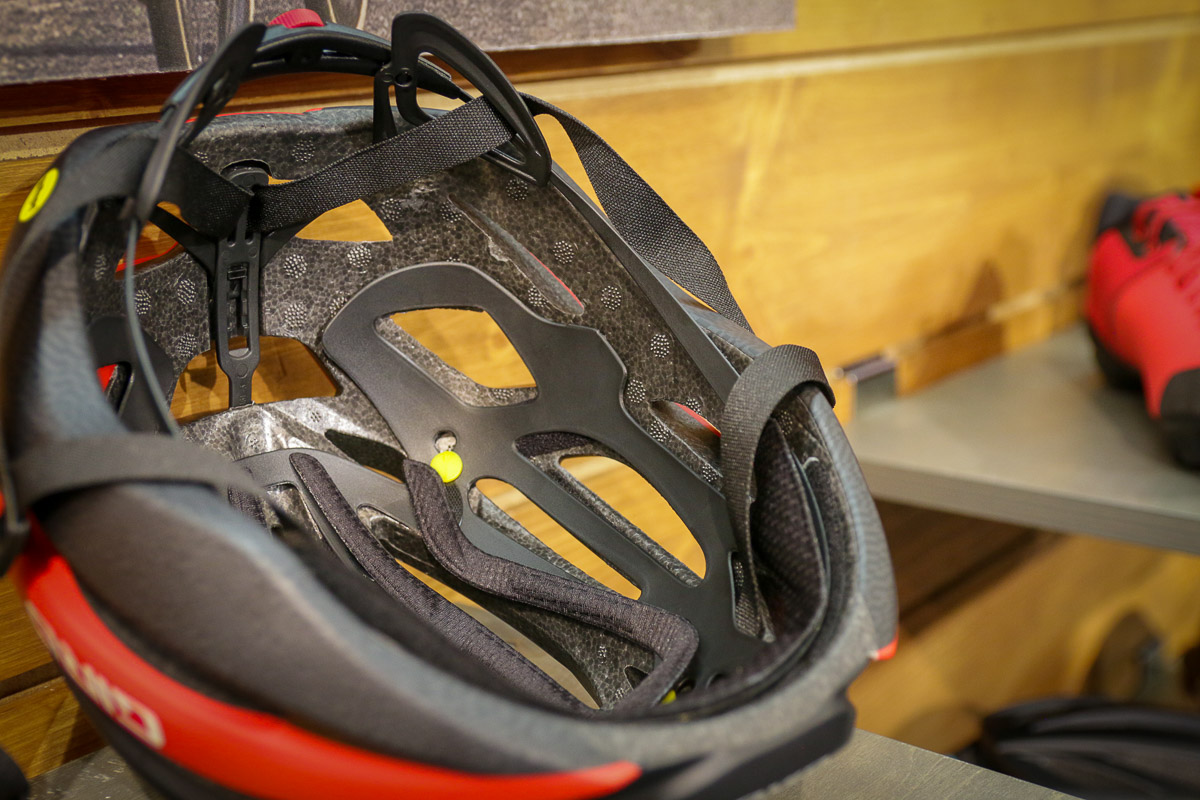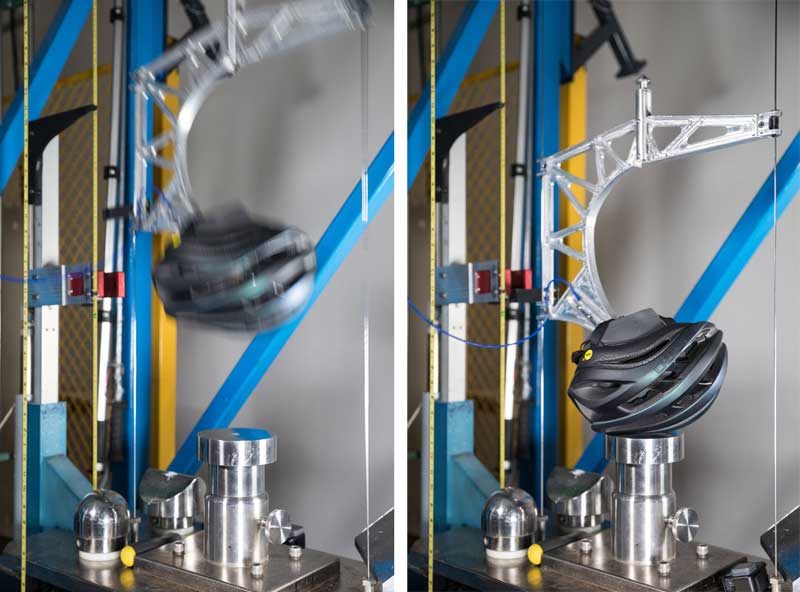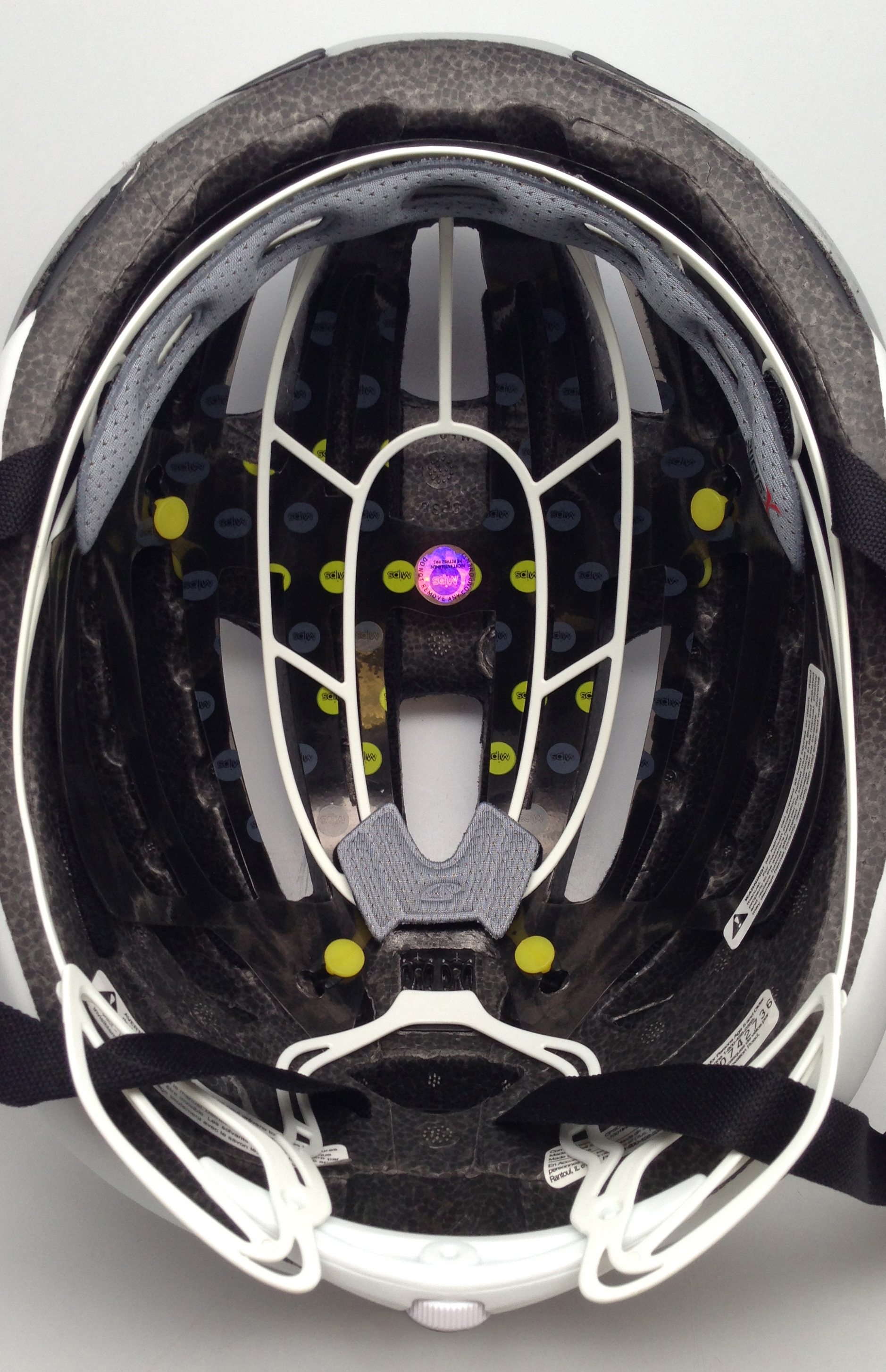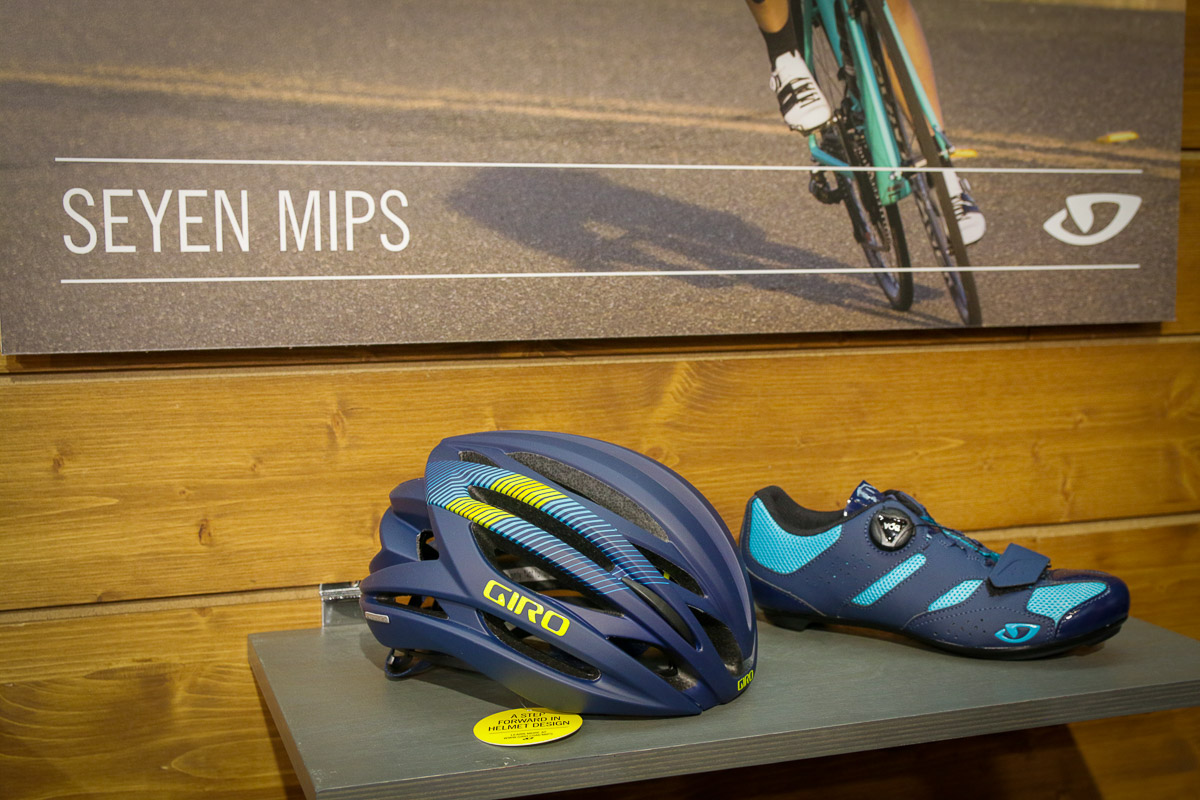We know, there’s no such thing as a stupid question. But there are some questions you might not want to ask your local shop or riding buddies. AASQ is our weekly series where we get to the bottom of your questions – serious or otherwise. Hit the link at the bottom of the post to submit your own question!
Originally, we had planned to have just one installment of the Ask Giro Anything, but we received so many questions that it needed to be split into (at least) two posts. Even still, there will be a few that we won’t get to, but Giro answered a ton of questions on everything from the sometimes ambiguous, jargon-filled world of helmet safety, to individual fit, and more. Getting right to it, here’s part two!
MIPS
It seems that ever since the launch of MIPS (Multi-directional Impact Protection System), there have been questions about it. How does it work? Isn’t it the same as wearing a cap under your helmet or just having hair? Is it really safer? Giro tackled those questions and more – specifically when it comes to knowing just how “safe” your helmet really is.
Does MIPS not function just as well as a full head of hair and a cap? Wouldn’t a bald head with some Vaseline offer at least as much play and protection from the same forces?
Giro: The theory that hair, skin oils, sweat, loose-fitting helmets or wearing a cap under the helmet can provide the same benefit as MIPS technology is false, and could in fact be dangerously so. In short, the reasons are two-fold: first, all of those factors are variables that cannot provide a consistent or predictable benefit during an impact and may in fact compromise the helmet’s ability to do its’ job; and secondly, MIPS technology relies on a slip plane that is specifically engineered to move consistently, even under load as the impact is happening. Hair, oil, etc. are not engineered to do this and testing shows that they do not have the same ability to slip or move under load. The forces involved in an impact can involve hundreds of pounds of pressure per square inch within 0.002 seconds – that’s the amount of time it takes for impact energy to be transferred to your brain and it’s about 100x faster than the blink of an eye. So, to get the benefit of MIPS technology – where the helmet’s shell is able to move independently to redirect impact energy away from the brain – requires more than simply theoretical potential for the helmet to move a little.
How does MIPS Spherical compare in effectiveness to POC’s spin technology?
Giro: While the technologies share a similar intent – to reduce rotational energy that can be transmitted to the brain from angled impacts – they have different backgrounds. MIPS pioneered the research that is leading the evolution in helmets to more comprehensively understand and address rotational forces, and based on the extent of their research and our own testing, we believe it is the leading technology at this time.
How does attaching lights, cameras, and other accessories to a helmet affect its ability to protect from a crash?
Giro: As we’ve stated below, every crash is a unique event, so adding variables like a camera or lights only further highlights why we can’t make a simple prediction about how they could affect a helmet’s performance during an impact. We’ve been testing for these types of scenarios for several years and working directly with camera and light brands to better understand how to incorporate and manage them. The result is that we have recommended following manufacturer guidelines for installation and use, and we have designed “break-away” mounts that can make it easier to securely mount accessories and can also help to prevent them from being damaged during impacts.
How safe is my helmet?/Safety testing and rating
The next few questions all funnel into the same response form Giro, below.
I understand that all helmets must meet safety regulations. Technologies like MIPS are supposed to make helmets safer. Other than that understanding, the consumer has no idea whether one helmet is safer than another. Is there a hierarchy of safety? For example, is a high end lightweight helmet like the Synthe sacrificing any real-world safety in comparison to a heavier helmet?
Do you think that broad helmet safety standards hinder or prevent the development of safer cycling-specific headgear?
Giro: The short answer to your questions is no. But please read on…
Why don’t you rate your helmets’ safety? Or release performance data on safety tests. Not everyone wants the most aero or ventilating helmet. Some people just want the safest helmet.
Giro: The short answer to your questions is that we can’t rate helmets for “safety”. But please read on to learn why…
What does Giro think about the bike helmet testing done so far by Virginia Tech and the IIHS?
Giro: Please read the note on Virginia Tech below. We have been working with them for some time, and this is a notable development in the helmet business.
Will we (consumers) ever be able to review actual helmet test data? Actual transmitted G forces? Or will we continue to just get pass/fail results based on the industry certifications? If not, what’s the rationale behind that? I’m not trying to pick on you (I like Giro), I’m asking with regards to the industry as a whole. For example, I like that I can see whether my car passed or failed industry crash test standards. Great. But what’s even better is that I can get an actual score of how it does in different tests and even view crash footage. While not everyone goes to the lengths to research this, I feel it’s important to have available so that the consumer can make the best educated decision regarding their safety.
Giro: The short answer to your questions is no. But please read on to understand why we cannot share data at this time.
THE BIG ANSWER. Perhaps the best way to untangle some common misunderstandings or questions about head protection is to start by acknowledging that helmet standards are commonly labeled as “safety standards” in many conversations, and the word “safety” usually refers specifically to how effectively a helmet can manage impact energies (how big of a hit can it take and still prevent a brain injury). These are understandable conventions, but they are not really accurate. This is important to understand because the scope of things a helmet standard has to address is much broader than simply how a helmet manages impact energies, and a helmet’s protective capability is defined by more than how much energy it can manage during an impact (though this is obviously a very important consideration).
WHAT ARE THE STANDARDS? There are multiple standards that govern cycling helmets. The primary standards we’ll consider in this answer are government mandated standards that cover helmet design and sales across different markets – CE EN1078 (aka the “European” standard), CPSC (the “American standard), AS/NZ (the “Australian” standard) as well as independent and voluntary standards from groups like ASTM, Snell and others that helmet brands can incorporate into their product designs. The number of different standards and the way that people can interpret them is why people often ask if one standard is better or “safer” than another. You can read more about the standards at helmetfacts.com to understand how they vary and where in some cases, they align. It’s a good read, but takes some time…
WHY DO WE FOLLOW THE STANDARDS, AND WHICH ONES? The general purpose of helmet standards is to provide a comprehensive set of criteria that allows for relevant design, manufacturing, testing, use, and validation of products within their specified intent. In short, standards are not just “safety regulations”. They exist to ensure that products meet a threshold for quality, durability and consistency, and provide a predictable and relevant benefit to the user (including but not limited to how they perform during impact testing). We are required by law to meet the standards that are set for each global market, and in some cases, we also meet additional voluntary standards (such as the ASTM “downhill” helmet standard) when they are relevant to the activities a given helmet is designed for.
WHAT IS THE PUPOSE OF IMPACT TESTING? When it comes to impact testing, the criteria are intended to help understand how a helmet can manage the forces that could likely be encountered in a given activity (cycling) based on common use scenarios, crash data and/or injury research. It is important to note that there is no laboratory test or standard that can possibly address every potential scenario a rider may encounter in real world activity.
WHY ISN’T THERE A RANKING OF HELMETS OR STANDARDS? Since a test or a standard cannot address every variable or possibility a rider may encounter in the real world, we cannot make a claim that one test, one standard or one helmet is better or safer than another in every sense or every case. This is why there is no ranking or “hierarchy” to helmet standards (or helmets).
That said, Virginia Tech has published a “5-star” rating system of cycling helmets to help provide consumers with insights on how well helmets perform in their testing. The team there has just completed their first, limited batch of helmet ratings with more to come. We have worked with Virginia Tech to share insights and to ensure that we understand their testing and criteria so that we can act on any relevant findings in the future.
WHY CAN’T WE MAKE A CLAIM ABOUT SAFETY OR RELEASE DATA? If we were to limit the scope of discussion to impact testing and energy management, we still could not claim that one helmet is safer than another, because in order to make that claim we would need to make a prediction. To predict that one helmet would be more effective (aka “safer”) than another helmet, we’d have to know very precisely how you were going to crash, the forces and variables involved and where the injuries would occur. The truth is, every single crash or impact is a unique event, and therefore we simply can’t make a prediction. There are too many variables for anyone to know ahead of time – speed, surface, temperature, trajectory, mass, objects encountered, etc. that it would be irresponsible of us to make claims that could lead you to a false sense of security.
Even if we were to rely solely on test data, we could not make this claim because the lab is not the real world and there is no definitive threshold for when brain injury occurs in every person – nobody can say exactly how much force it takes to injure the brain.
Every helmet tested in the lab is subject to the variables of that test batch, and results can vary from test to test within specified limits. This is partially why we don’t release data – it could be used or interpreted incorrectly and lead a customer to choose equipment that isn’t relevant to their use or to make conclusions about products that are beyond our intent.
SO WHAT IS OUR RECOMMENDATION? We recommend a few things:
- Always wear a helmet when riding.
- Make sure you ride in a helmet that is sized correctly, is adjusted to fit correctly as spelled out in the owner’s manual (straps, buckles and fit system all in proper adjustment), is in good condition and designed for the type of riding you do.
- Wear a helmet that provides as much coverage as you’re comfortable with, since a helmet cannot offer protective capability for areas it doesn’t cover.
- Inspect your helmet regularly for signs of damage or potential compromises in performance (dents, cracks, frayed straps, missing parts, etc) and replace it before riding if you have reason to believe it’s not in good working condition
- Replace your helmet every 3-5 years. Helmets can degrade over time through use, handling, and so on. And we believe that helmets continue to improve through design, innovations like MIPS and the evolution of standards.

Helmet Fit & Shapes
Speaking of fit, there were a lot of specific questions about individual helmet fit. Helmets for big heads, long heads, wide heads, you name it – we got it. There were also a few other interesting questions that are worthy of answering.
Which helmet do you recommend that will not make me look like Toad from Super Mario Bros.?
Giro: Since we can’t work with you in-person to learn about the riding you do and what your personal preferences are, we’d recommend that you visit a retailer and try several helmets to find one that fits your needs and suits your style. Helmets are deeply personal and you should always strive to find one that fits correctly, is relevant to the riding you do, and that you feel good about wearing.
The shape of my head means that I fit well in some helmet brands but find others particularly uncomfortable. Why do helmet companies stick to a certain head form? Would making them in different widths (like shoes) make them a lot more expensive?
Giro: It’s normal to encounter helmets that fit better or more comfortably than others, even when they’re designed by the same brand on the same headform. The reason is that each helmet model has a unique design and no two human heads are the same. This is why we offer so many models and sizes.
The vast majority of our helmets are available in 2 or 3 sizes, and some are available in 4 sizes – a range that covers roughly 98% of the human population. Our sizing and fits are based on more than 30 years of experience handcrafting helmets as well as “human scale factors” data from the International Standards Organization.
Increasing the number of sizes or shapes does increase cost because every step of the process – from design to testing and manufacturing to warehousing – would require more time and investment without a linear increase in sales. This means that cost per sale would increase, distributors and retailers would have to allocate more space to stock helmets, etc. The end result would likely be a more expensive helmet, and also less choice in color, style, etc.
I have a wide head. Helmets that fit width-wise tend to be too long and there is a gap between my head and the back of the helmet. Is this unsafe and are there Giro helmets better for wider heads?
Giro: It is essential to make sure that you get a comfortable and secure fit so that the helmet cannot be rolled or twisted off. This doesn’t mean that every part of the helmet’s foam liner has to be in direct contact with your head. The helmet’s fit and stability system (aka: Roc Loc or similar) helps to ensure that a helmet can be adjusted to fit your head securely, while leaving room for airflow and the ability to adapt to different head shapes and sizes. We strongly recommend checking a fit guide (like the one posted here), following the instructions supplied in the owner’s manual and/or getting personal assistance at your local retailer if needed.
How much of a gap between the shell and my head is too much? I would imagine that the helmet can’t really do it’s job of absorbing the impact until it has something on the inside to compress against, and that the motion of it traveling toward your head should be minimized, so hoping you could speak to that briefly.
Giro: There’s not a specific measurement we can call out, because there’s not really a good way to take the measurement very consistently or precisely, and heads and helmets are not spherical – so the gap may vary depending on head shape and helmet shape.
The best recommendation we can make (and one that covers full-face helmets as well) is to select the helmet size that allows for the closest fit that’s comfortable, and that allows proper adjustment so that it can’t be rolled off, or moved enough to be unstable or compromise vision when you’re riding.
This video shows how to find the right fit:
I can’t be the only one who has difficulty finding a helmet that doesn’t dig painfully into my forehead. Currently riding with a Giro Hex with the front pads and hook and loop fasteners removed. With many helmet manufacturers moving to MIPS or similar, I fear that I won’t be able to find a helmet that fits in the future. My head is 64 cm, and oval shaped.
Giro: Having a helmet dig into your forehead uncomfortably is not cool. Assuming that this isn’t due to overtightening the helmet’s fit system or wearing a helmet that’s too small, we suggest trying a helmet like the Chronicle MIPS in size XL, or the Compound MIPS. These are just a couple of the newer helmet models we offer in a size XL to accommodate sizes above 60cm in diameter. Comfort is important, so we recommend trying several models if you can, to find the best, secure fit. When it comes to getting a comfortable fit with MIPS, it’s important to know that helmets are often now designed with MIPS in mind from the start and this development has improved comfort in many cases.
I have contact dermatitis possibly from latex or other chemicals used to manufacture helmets. I have a reaction like poison ivy. What are my options for owning a helmet? Have tried Poc and Smith. Just purchased a Giro. Haven’t tested it yet. I used to wear a Xen for many years and loved it! Wish it was still with me. Is there latex in the helmet pads or possibly used to mold the helmets? I have a latex reaction (the poison ivy-like reaction. Type IV Hypersensitivity), no helmet I can find for bicycles is certified latex free. And I have to protect my noggin!! Please help.
Giro: If you’ve used the Xen without any issues, the good news is that many of our newer helmet models should be fine since the materials used are the same. The Chronicle helmet would be a good starting point if you’re looking for a similar style to the Xen. That said, the factory where our products are made may do work with other brands or products that may contain the materials you’re sensitive to. We suggest working with a local retailer or a friend to see if you can borrow or rent a helmet that fits you, as a trial. You can clean a helmet before and after use with a cloth or sponge, warm water and mild dish soap to make sure that it’s clean.
Will Giro ever go back to offering more size choices (XXS, XS) not just a S-M, L-XL? I hate using a generic (one size fits all) lids and then using ratchet dials to adjust to fit. I used to swear by Giro, simply because of fit, but no longer.
Giro: Very few of our models are only available in a single size. In fact, we make a majority of our models in 3 sizes, and some in 4 sizes to help achieve the best fit possible. We believe that the fit systems in modern helmets are definitely an improvement over older helmets that don’t include them because they offer a range of adjustment that allows for both vertical as well as circumferential adjustment, helping you to get a more secure, stable fit than you can simply adding, moving or removing pads. Even our lower-cost Universal Fit helmet models are commonly available in 2 sizes, so hopefully you’re able to find a helmet that suits your style and fits correctly.
As a fairly oval-headed wearer of bicycle and motorcycle helmets, this issue is a big issue for me. Forehead pain/pressure is the worst! And it usually doesn’t rear it’s ugly head until well after the casual test stroll around the shop! Has Giro studied what constitutes an “oval” head vs a “round” head (like a length to width ratio of the head or something like that). Has Giro studied populations to determine how many round-headed wearers vs oval-headed wearers there are and what countries they live in? Or considered including information on each helmet about how oval it is? Some motorcycle companies do this (for instance, Arai). Is there just one “last” they use to shape helmet models around? Thanks for your time, it’s an interesting, wide-ranging subject and I don’t envy you guys trying to design helmets for all the different weird human head shapes!
Giro: There is no industry or common standard for what defines “oval” vs “round” fit, but in general Giro’s fit is classified as “oval”. Our headform started with data from the ISO (International Standards Organization) and has evolved over more than 30 years based on rider feedback, changes in fit systems and padding, and technologies like MIPS that sit within the helmet. Each helmet model is different too, meaning that it may contact your head in slightly different areas, which may be more or less comfortable to you.
When it comes to a comfortable fit, we can’t overstate the importance of trying several different models and sizes, and to be sure that the helmet is properly adjusted. The difference between a comfortable fit and an uncomfortable fit can be a single millimeter or two, and most helmets offer a range of adjustment that can eliminate discomforts.
The number one complaint I hear from long-haired helmet owners: The fit systems in most, if not all helmets pulls out hair. The hair removal feature is emphasized with the MIPS liner. Do most helmet engineers and testers have short hair, or is it an issue you are considering resolving? The helmets ability to keep hair attached to the scalp seems to be the one of the most over-looked things that will turn the long-haired folks toward a helmet.
Giro: We’re not all short-haired here – in fact, nearly half of our staff is female and several of the designers and engineers have hair that’s long enough to get caught in things like fit systems. We are constantly looking for ways to address this challenge, and helmets like our new Aether model actually do reduce instances of hair pulling since the MIPS is embedded between layers of foam, instead of against your head.
Will Giro adopt BOA in future helmet models?
Giro: It’s possible, but there are no plans we can share, currently.
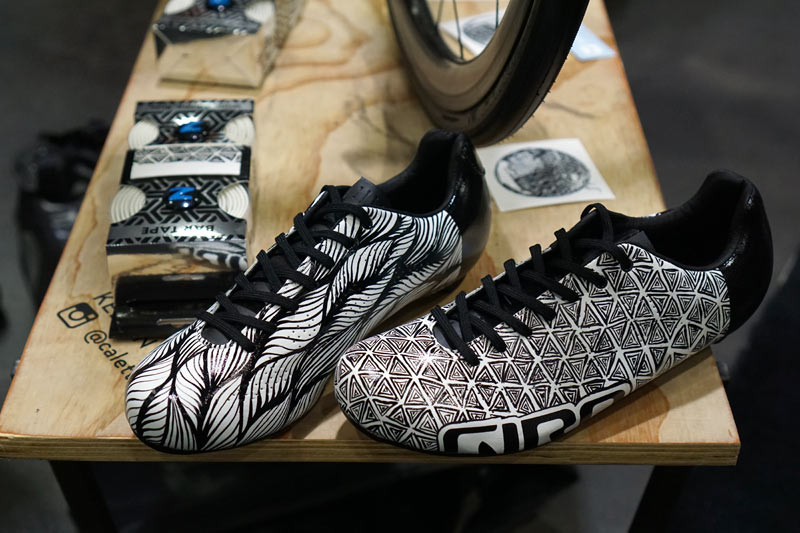
Clothing & Gear
What’s the best shoe paint with which to customize Giro shoes?
Giro: Word on the street is Posca brand. We love art and support personal expression on your shoes but you have to understand that painting your shoes violates our warranty policy without exception.
I’ve always been a fan of your products. My question is, in the past years, I’ve seen that the ladies’ helmets and shoes have far more appeal in colors, designs, and finishing touches compared to the men’s. I’ve seen colored straps, leather patches, unique designs that transcend gender. So, I want to know, do the helmets and shoes fit the same? I wear a 41-42 depending on which model shoe, so do they fit the same in the women’s line? Thanks! And keep up the good work.
Giro: Our Women’s Series helmets are built on the exact same tooling and to the exact same standard as our unisex helmets – they are identical save for the aesthetic touches you mention. We can do this because the human head doesn’t have the same kind of variance in proportion or shape that you’d observe between men’s and women’s hands, feet, hips, etc.
Our women’s shoes, gloves and apparel however are made on patterns and forms that are uniquely tailored to fit women. Women’s shoes are narrower in the heel than men’s shoes, have a slightly narrower fit and lower volume in the forefoot, and are available in a size range that is smaller than the men’s range (only up to size 43).
Got a question of your own? Click here to use the AASQ form, or find the link under the Contact menu header up top anytime a question pops into your mind!

